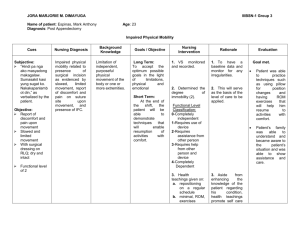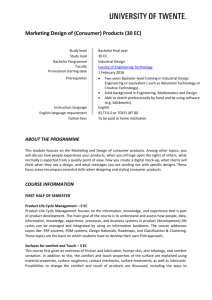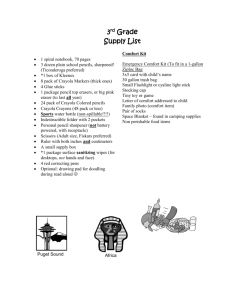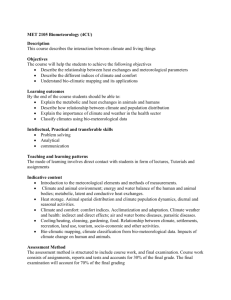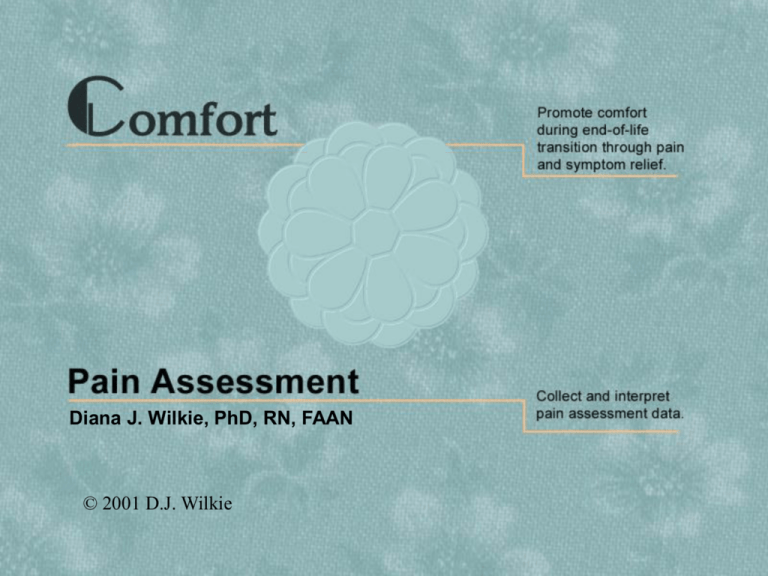
Diana J. Wilkie, PhD, RN, FAAN
© 2001 D.J. Wilkie
Comfort: Pain Assessment
Pain
What is assessed?
• The word “pain” means
different things to different
individuals
• The differences among pain,
nociception, and suffering
are helpful in adopting
professional definitions
TNEEL-NE
Mr. Sen
•
A hospice nurse tries to learn
more about Mr. Sen’s pain
Slide 2
Comfort: Pain Assessment
Clinical Definition of Pain
“Pain is whatever the person
says it is, existing wherever the
person says it does.”
“I feel sick in my stomach – it hurts something awful.”
(McCaffery, 1999)
TNEEL-NE
Slide 3
Comfort: Pain Assessment
Scientific Definition of Pain
“So you’re telling me it’s a sharp pain, right below your navel.”
“Yes!”
“An unpleasant sensory and
emotional experience
associated with actual or
potential tissue damage, or
described in terms of such
damage”
Reprinted from Classification of chronic pain: descriptions of chronic pain syndromes and definitions of
pain terms.Prepared by the Task Force on Taxonomy of the International Association for the Study of
Pain. Ed. Harold Merskey & Nikolai Bogduk (Seattle: IASP Press, 1994). Permission: International
Association for the Study of Pain.
www.halcyon.com/iasp
TNEEL-NE
Slide 4
Comfort: Pain Assessment
Nociception Definition
•The activation of primary afferent
nerves with peripheral terminals that
respond differently to noxious (i.e.,
tissue damaging) stimuli
•Nociception may or may not be
perceived as pain, depending on a
complex interaction within the
nociceptive pathways
TNEEL-NE
Slide 5
Comfort: Pain Assessment
Suffering
“The state of severe distress
associated with events that
threaten the intactness of the
person”
Reprinted from Cassell, EJ, Nature of suffering the goals of medicine. New England Journal of Medicine (1982) Mar
18 306(11) 639-45. ©1982 Massachusetts Medical Society. All rights reserved.
TNEEL-NE
Slide 6
Comfort: Pain Assessment
Multiple Dimensions of Pain
The ABCs of Pain
Affective Dimension
Behavioral Dimension
Cognitive Dimension
Physiological-Sensory Dimension
TNEEL-NE
Slide 7
Comfort: Pain Assessment
Nociceptive Pain Definition
Pain resulting from activation
of primary afferent
nociceptors by mechanical,
thermal or chemical stimuli
TNEEL-NE
Slide 8
Comfort: Pain Assessment
Neuropathic Pain Definition
Pain resulting from damage to
peripheral nervous or central
nervous system tissue or from
altered processing of pain in
the central nervous system
TNEEL-NE
Slide 9
Comfort: Pain Assessment
Experts: Of What ?
• Physicians
– Diagnosing and treating the health problem
• Nurses
– Monitoring the health problem & treatments
– Diagnosing & treating pain responses
• Other Health Professionals
– Diagnosing & treating a specific
aspect of health problem
TNEEL-NE
Slide 10
Comfort: Pain Assessment
Experts: Of What ?
• Patient
– Pain sensation & relief
– Attributed meaning
• Family Members
– Reporting presence or
absence of pain
– Less reliable reporting
intensity, location,
quality or pattern of pain
TNEEL-NE
Who is the
ultimate expert?
THE PATIENT!
Health care
professionals only
know how a
person’s pain feels if
the person tells or
shows them.
Slide 11
Comfort: Pain Assessment
Goal of Care: Cure
Treatment of disease or illness
with intent to overcome it
TNEEL-NE
Slide 12
Comfort: Pain Assessment
Goal of Care: Palliation
Treatment to relieve the
symptoms and distress of the
disease process or illness
TNEEL-NE
Slide 13
Comfort: Pain Assessment
What is the Goal of Care?
Curative & Palliative
• Example: Right upper quadrant pain,
exacerbated by eating fatty meals
– See the difference between curing a disease as
a means of treating pain and palliating all pain
the
cure
forcure
this
new
Q:
Q:Is
Q:
What
What
cause
areisis
the
a
of
likely
likely
the
cause
pain
palliative
after
ofthat
that
the
treatments
pain?
surgery
Q:the
What
will
likely
pain?
the
forfor
same
this
new
aspain?
before?
pain?
that
A: Surgery
A: Gallbladder
disease
A: Time,
wound
healing
A:
No,
it’smedications
likely
to beoccurs
A:as
Pain
post-operative incision pain
TNEEL-NE
Slide 14
Comfort: Pain Assessment
Assess or Measure Pain?
TNEEL-NE
Slide 15
Comfort: Pain Assessment
Definition of Assessment
“The act of determining the
importance, size, or value of
something. Making an
estimate”
By permission. From Merriam-Webster's Collegiate Dictionary, Tenth Edition c 2001 by MerriamWebster, Incorporated.
TNEEL-NE
Slide 16
Comfort: Pain Assessment
Definition of Measurement
“The act of applying a metric to
quantify how much there is of
something”
By permission. From Merriam-Webster's Collegiate Dictionary, Tenth Edition c 2001 by Merriam-Webster,
Incorporated.
TNEEL-NE
Slide 17
Comfort: Pain Assessment
Physiological Dimension
• Etiology
– Chronic
– Acute
– Malignant
• Pathology
– Somatic Tissue
– Visceral Tissue
– Neural Tissue
TNEEL-NE
Pain Assessment Data
LINK
Neural Mechanisms
of Pain
Slide 18
Comfort: Pain Assessment
Sensory Dimension:
A Critical Component
4
Four aspects are critical to
understand if the pain is nociceptive
or neuropathic in its etiology
• Obtain Self Report Data from Patient:
–
–
–
–
TNEEL-NE
Location
Intensity
Quality
Pattern
Slide 19
Comfort: Pain Assessment
Pain Location & Distribution Data
Important Clue
• Helps to determine pain etiology
• Suggests definitive treatment for the problem
causing the pain
• Clue to pathologic pain processing
• Clue to appropriate pain treatment
– Palliate pain
– Relieve pain
TNEEL-NE
Slide 20
Comfort: Pain Assessment
Pain Location
Clue to etiology & effective treatment of the pain
• New Site: Must determine etiology
– Requires proper diagnosis of the cause of pain to assure
appropriate treatment
• Previously Existing Site
– Requires effective treatment based on patient
characteristics and nature of the pain
• body area
• spinal dermatome
TNEEL-NE
Slide 21
Comfort: Pain Assessment
Measuring Pain Location
Right
Left
Right
Copyright 2001 D.J. Wilkie & K.A. Puntillo all rights reserved
TNEEL-NE
Slide 22
Comfort: Pain Assessment
Measuring Pain Location
Right
TNEEL-NE
Left
Right
Slide 23
Comfort: Pain Assessment
Localized Pain
•
•
•
•
•
Confined to original site
Doesn’t radiate
Cutaneous hyperalgesia
Allodynia
Deep tenderness
Example: tendonitis, arthritis, surgical incisions
TNEEL-NE
Slide 24
Comfort: Pain Assessment
Projected Pain:
Transmitted or Transferred
• Radiates along nerve in a segmental or
peripheral distribution
Example (segmental): herpetic neuralgia
Example (peripheral): trigeminal neuralgia
TNEEL-NE
Slide 25
Comfort: Pain Assessment
Spinal Dermatomes
Spinal
Dermatomes
C=Cervical
Copyright 2001 D.J. Wilkie
TNEEL-NE
Slide 26
Comfort: Pain Assessment
Spinal Dermatomes
Spinal
Dermatomes
T=Thoracic
Copyright 2001 D.J. Wilkie
TNEEL-NE
Slide 27
Comfort: Pain Assessment
Spinal Dermatomes
Spinal
Dermatomes
L=Lumbar
Copyright 2001 D.J. Wilkie
TNEEL-NE
Slide 28
Comfort: Pain Assessment
Spinal Dermatomes
Spinal
Dermatomes
S=Sacral
Copyright 2001 D.J. Wilkie
TNEEL-NE
Slide 29
Comfort: Pain Assessment
Referred Pain
• From deep somatic or visceral site to cutaneous
region distant but within several segments
• +/- hyperalgesia or allodynia, deep tenderness,
muscle spasm
• No muscle atrophy or weakness
• No change in peripheral reflexes
Example: shoulder pain - subphrenic abscess
TNEEL-NE
Slide 30
Comfort: Pain Assessment
Referred Pain Sites: Examples
Copyright 2001 D.J. Wilkie
TNEEL-NE
Slide 31
Comfort: Pain Assessment
Referred Pain Sites: Examples
Copyright 2001 D.J. Wilkie
TNEEL-NE
Slide 32
Comfort: Pain Assessment
Referred Pain Sites: Examples
Copyright 2001 D.J. Wilkie
TNEEL-NE
Slide 33
Comfort: Pain Assessment
Referred Pain Sites: Examples
Copyright 2001 D.J. Wilkie
TNEEL-NE
Slide 34
Comfort: Pain Assessment
Other Distributions
Central vs. Psychologic Pain
• Whole or hemi body
• Glove or stocking
• Doesn’t fit normal neuroanatomy
Examples:
• Thalamic pain
• Sympathetically maintained pain
• Hyperalgesia & allodynia
• Vasomotor & trophic changes
TNEEL-NE
Slide 35
Comfort: Pain Assessment
Location & Distribution Data:
Clue to Type of Pain:
Nociceptive Pain
• Localized Distribution
– Somatic tissue (skin, muscle, bone)
• Diffuse or Referred Distribution
– Visceral tissue
(located in areas distant from internal organ)
• Usually responds to acetaminophen,
NSAIDs or opioids depending on severity
TNEEL-NE
Slide 36
Comfort: Pain Assessment
Location & Distribution Data:
Clue to Type of Pain:
Neuropathic Pain
• Distribution is projected along a nerve or a
nerve root segment
• Allodynia & hyperalgesia is present
• Often responds to adjuvant drugs
–
–
–
–
–
TNEEL-NE
tricyclic antidepressants
anticonvulsants
neuroleptics
clonidine
baclofen
Slide 37
Comfort: Pain Assessment
Pain Intensity or Severity
Clue to Drug & Dose
• Initial Pain Intensity Score
– Gross clue to appropriate drug to
relieve the pain based on WHO Analgesic
Ladder
10
8
• Step One Drug
• Step Two Drug
• Step Three Drug
– Clue to starting dose
• Subsequent Scores
– Guide dose titration
– Guide decision to switch to another drug
TNEEL-NE
1
Slide 38
Comfort: Pain Assessment
Pain Intensity or Severity:
Clue to Drug & Dose
Compare patient’s goals for optimal and able to tolerate pain
intensity levels with experienced pain intensity:
• Pain now plus its least & worst in past 24 hours
– at rest
– with activity (sitting, walking, coughing, breathing)
• At analgesic effect point for drugs
– Onset: It starts to work
– Peak: Its maximal effect and time point when another
dose can be safely administered
– Duration: Its length of effect and time point when
another dose is needed
TNEEL-NE
Slide 39
Comfort: Pain Assessment
Analgesic Ladder
Pain relief
Step 3
Opioid for moderate to severe pain
+/- Non-opioid
+/- Adjuvant
Pain persisting
Step 2
Opioid for mild to moderate pain
+/- Non-opioid
+/- Adjuvant
Pain persisting
Step 1
Non-opioid for mild pain
+/- Adjuvant
PAIN
TNEEL-NE
Source: World Health Organization, 1992
Slide 40
Comfort: Pain Assessment
Pain Intensity or Severity
Discomfort
PAIN
Hurt
Pain perception
TNEEL-NE
Slide 41
Comfort: Pain Assessment
Pain Intensity or Severity
Script: Using Pain Intensity Number Scale (PINS) (0-10)
"I need to know how much pain you have in order to help you
with pain control. Because I can't feel your pain, I want you to
use a scale to let me know how much pain you have right now.
The numbers between 0 and 10 represent all the pain a person
could have. Zero means no pain and 10 means pain as bad as it
could be. You can use any number between 0 and 10 to let me
know how much pain you have right now. Call your pain a
number between 0 and 10 so I will know the intensity of the pain
you feel now.”
© 1990, 2001 D.J. Wilkie
TNEEL-NE
Slide 42
Comfort: Pain Assessment
Therapy Goals
• Patient
– Optimal Goal (Preferred Intensity)
– Able to live with (Can Tolerate)
• Others in Environment
–
–
–
–
TNEEL-NE
Nurse
Physician
Other Health Professionals
Family & Friends
Slide 43
Comfort: Pain Assessment
Pain Quality or
Nature of the Pain
Clue to Drug and Nondrug Therapy
• Clue to type of pain:
– nociceptive or neuropathic
• Clue to appropriate drug to relieve pain
– burning pain often responds to tricyclic antidepressants
– shooting/stabbing pain often responds to anticonvulsant
or other adjuvant drugs for neuropathic pain
• Clue to need for emotional support
• Clue to patient’s ability to cope
TNEEL-NE
Slide 44
Comfort: Pain Assessment
Pain Quality
“Most important distinguishing
characteristic”
Indicates etiology is nociceptive or neuropathic.
– superficial
– deep
– somatic tissue
– visceral tissue
– neural tissue
(Bonica, 1990)
TNEEL-NE
Slide 45
Comfort: Pain Assessment
Pain Quality Descriptors
Nociceptive Pain
•
•
•
•
•
•
•
•
•
Cramping • Squeezing
Crushing • Tender
Cutting
• Throbbing
Lacerating
Piercing
Pinching
Pounding
Pressing
Sharp
TNEEL-NE
Neuropathic Pain
•
•
•
•
•
•
•
•
•
Drilling
Flashing
Lancinating
Numb
Radiating
Burning
Shooting
Stabbing
Tingling
Slide 46
Comfort: Pain Assessment
Pain Pattern
Temporal nature of pain
– Pattern of the pain
• Onset
• Duration
– How pain changes with time
• Periodicity of least and worst pain
• What makes the pain worse or better
TNEEL-NE
Slide 47
Comfort: Pain Assessment
Temporal Pattern:
Onset, Duration, Periodicity
tlc douloreux
toothache
angina
intestinal colic
continuous,
fluctuating
continuous,
nonfluctuating
TNEEL-NE
Slide 48
Comfort: Pain Assessment
Pain Pattern Words
Continuous
Steady
Constant
Rhythmic
Periodic
Intermittent
Brief
Momentary
Transient
TNEEL-NE
Slide 49
Comfort: Pain Assessment
Pain Pattern
Clue to Timing of Drug & Nondrug Therapies
• Clue to guide interval between analgesic
doses
– q 1 hr vs Around The Clock (ATC)
• Clue to appropriate time to introduce and
apply nonpharmacologic therapies
TNEEL-NE
Slide 50
Comfort: Pain Assessment
Reporting Sensory Pain
Information
• Use similar language as medical colleagues
– Seven aspects of symptom analysis:
• Onset, Duration, Location, Intensity, Quality,
• Aggravating & Alleviating factors
Documentation in the medical
record is essential!
TNEEL-NE
Slide 51
Comfort: Pain Assessment
Reporting Sensory Pain
Information
• Nurse colleagues
– Shift report
• location, intensity, quality, pattern, of pain
• pain relief response to analgesics administered
• Other health professionals
– Physician colleagues
• reinforce effectiveness of treatment plan
• especially when pain relief is inadequate
TNEEL-NE
Slide 52
Comfort: Pain Assessment
Affective Response:
Negative Emotions
Anger
Fear
TNEEL-NE
Anxiety
Depression
Slide 53
Comfort: Pain Assessment
Affective Response:
Positive Emotions
Humor
Joy
TNEEL-NE
Laughter
Pleasure
Slide 54
Comfort: Pain Assessment
Behavioral Responses
Control the Pain
• Prevent onset of pain
• Reduce pain intensity
• Tolerate the pain
Controlling Pain:
Many patients
tolerate pain and
do not tell others
TNEEL-NE
Slide 55
Comfort: Pain Assessment
Behavioral Clues to Pain
Objective Data (NANDA, 2001)
•
•
•
•
•
•
•
TNEEL-NE
Guarding
Impaired thought process
Social withdrawal
Introspection
Altered time perception
Moaning
Crying
PAIN
Slide 56
Comfort: Pain Assessment
Behavioral Clues to Pain
Objective Data (NANDA, 2001)
•
•
•
•
•
•
TNEEL-NE
Pacing
Distracting self
Restless behavior
Facial Mask of Pain
Physical signs: diaphoresis
BP/Pulse/RR Change
Restless
Behavior: Not
being able to sleep
Slide 57
Comfort: Pain Assessment
Behavioral Clues to Pain
Subjective Data (NANDA, 2001)
• Verbal Report
–
–
–
–
TNEEL-NE
Location
Intensity
Quality
Temporal Pattern
Slide 58
Comfort: Pain Assessment
Behavioral Clues to Pain
Facial Expressions
• Poor indicators of pain experienced in
people who face the end-of-life transition
– Typical facial
expression of pain
illustrated by a
wounded soldier
San Francisco Examiner photo by Kim Komenich, reprinted with permission
TNEEL-NE
Slide 59
Comfort: Pain Assessment
Cognitive Responses
•
•
•
•
•
•
TNEEL-NE
Beliefs
Attitudes
Meaning of the pain
Memory of past pain
Cognitive resources to cope
Locus of control
Memories:
Connections to past
pain shapes a patient’s
response
Slide 60
Comfort: Pain Assessment
When to Assess?
• Initial:
– Assessment of the critical
components of pain
• Follow-up:
– Routine reassessments are
essential
Two Times: A
minimum of 2
times to assess
a patient
TNEEL-NE
Slide 61
Comfort: Pain Assessment
Initial Assessment
• When responsibility for patient care begins
• As complete as possible
BEFORE
treatment …
• At least:
–
–
–
–
Location
Intensity
Quality
Pattern
… BEGIN with
assessment
TNEEL-NE
Slide 62
Comfort: Pain Assessment
Follow-up Assessment
• At onset, peak, duration of analgesic
therapy provided
• Routinely
TNEEL-NE
Slide 63
Comfort: Pain Assessment
When to Assess?
Mr. Sen
The Follow-up: Mr. Sen is
treating his pain continuously,
and is now meeting with you,
taking a break from teaching
another Buddhist monk. Mr.
Sen is smiling and eating some
fish stew – the largest meal
he’s eaten in days. You again
ask him questions about his
pain – and find the results
much more encouraging than
earlier.
TNEEL-NE
Slide 64
Comfort: Pain Assessment
What Else to Assess?
• Side-Effects of Therapy
–
–
–
–
–
Constipation
Gastric Fullness
Nausea
Sedation
Dry Mouth
• Symptoms of Disease
– Dyspnea
– Fatigue
TNEEL-NE
Dry Mouth: A
common side
effect
Slide 65
Comfort: Pain Assessment
Measurement Tools
Multidimensional Tools
• McGill Pain Questionnaire
(Location/Intensity/Quality/Pattern-Affective-Behavioral-Cognitive)
• Brief Pain Inventory
(Location/Intensity/Quality/-Affective-Behavioral-Cognitive)
• Memorial Pain Assessment Card
(Intensity/-Affective)
• Painometer
(Location/Intensity/Quality)
TNEEL-NE
Slide 66
Comfort: Pain Assessment
Tools for Clinical Practice
• Example of PAINReportIt, the first
computerized McGill Pain Questionnaire.
• Several other
tools are
available to
measure pain
intensity.
TNEEL-NE
Slide 67
Comfort: Pain Assessment
Tools for Clinical Practice
• Painometer
TNEEL-NE
Slide 68
Comfort: Pain Assessment
Tools for Clinical Practice
• McGrath faces scale
TNEEL-NE
Slide 69
Comfort: Pain Assessment
Tools for Clinical Practice
• Italian color VAS scale
TNEEL-NE
Slide 70
Comfort: Pain Assessment
Tools for Clinical Practice
• Pediatric color VAS scale
TNEEL-NE
Slide 71
Comfort: Pain Assessment
Barriers
Related to Health Care Professionals
• Inadequate knowledge of management
• Poor assessment of pain
• Concern about:
– regulation of controlled substances
– side effects of analgesics
– tolerance to analgesics
• Fear of patient addiction
TNEEL-NE
Slide 72
Comfort: Pain Assessment
Promise Attentive Pain Care
Make Pain Visible as the 5th Vital Sign
• Obtain patient’s self report of pain
–
–
–
–
patient is the expert - data valid
review pain data often
display pain data in patient’s room & chart
share pain data during nursing report
• Set red flag for unrelieved pain
• Display usual pain experienced by patients
on the unit - day by day
TNEEL-NE
Slide 73
Comfort: Pain Assessment
Pain Assessment Summary
•
•
•
•
•
•
TNEEL-NE
What?
Who?
How to?
How to Report?
When?
Practice?
Important
Barriers
?
Just Do It!
Slide 74

